While there are many species of mushrooms that can appear green, they are not as common as mushrooms of other colors, such as white, brown or red. The green color of these mushrooms is a result of their unique pigments.
Green mushrooms can be found in habitats like forests, woodlands, grasslands and even on decaying logs. They grow in damp or shaded areas where they can thrive in moist conditions.
Not all green mushrooms are safe to eat. Many green mushrooms are toxic and can cause gastrointestinal distress or more severe health issues if ingested.
In some cultures, green mushrooms are usually associated with mysticism, folklore, and fairy tales, as they have an otherworldly appearance. In some cases, they are even considered magical or lucky. Some cultures have used green mushrooms in traditional medicine or spiritual rituals, especially those containing psychoactive compounds.
List of Green Mushrooms
- Russula virescens -The green-cracking russula
- Gliophorus psittacinus- Parrot toadstool or parrot waxcap
- Sarcomyxa serotina – Olive oysterling
- Russula aeruginea- the grass-green russula, the tacky green russula
- Lactarius semisanguifluus – Bloody Milk Cap
- Russula heterophylla- the greasy green brittlegill
- Chlorociboria aeruginascens- Green elfcup or the green wood cup
- Ramaria abietina- the green-staining coral
- Stropharia aeruginosa- verdigris agaric
- Entoloma rodwayi- green stem pinkgill
- Leotia viscosa – Chicken lips
- Cortinarius austrovenetus- green skin-head
- Entoloma incanum– Mousepee Pinkgill
- Chlorophyllum molybdites – the green-spored parasol
Description And Facts About Green Mushrooms
Russula virescens – Green-cracking russula
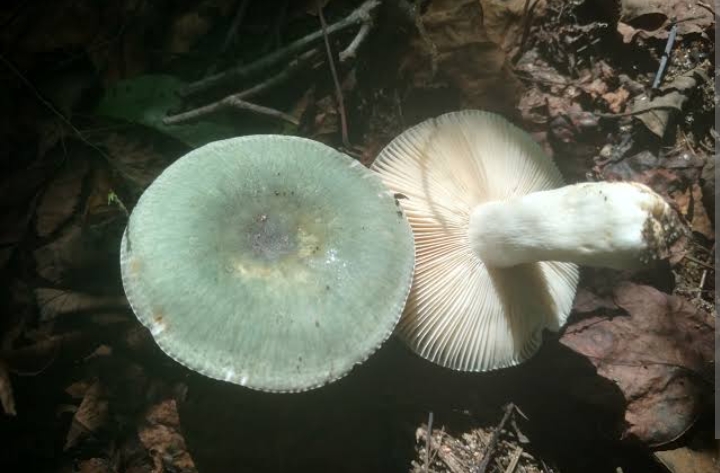
Russula virescens, commonly known as the Green-cracking Russula can be recognized by its pale green cap that measures up to 15 cm (6 in) in diameter. The cap surface may appear smooth when young but develops fine cracks or fissures with age.
The gills are white or cream-colored, and they are not attached to the stem (they are free gills). They are fairly crowded and thin.
The stem of R. virescens is also green and roughly cylindrical. It measures 4 to 10 cm in height and 1 to 3 cm in width. The stem lacks a prominent ring or skirt-like structure and is usually slightly paler in color toward the base.
The flesh is white and brittle. This mushroom is considered to be one of the best edible mushrooms of the genus Russula, it is especially popular in Spain and China. With a taste that is described variously as mild and nutty, it is cooked by grilling, frying and sautéing.
Russula virescens is a mycorrhizal mushroom. It forms a mutually beneficial relationship with trees and other plants. It is usually found in mixed hardwood forests, especially in North America and parts of Europe.
Gliophorus psittacinus- Parrot toadstool or Parrot waxcap
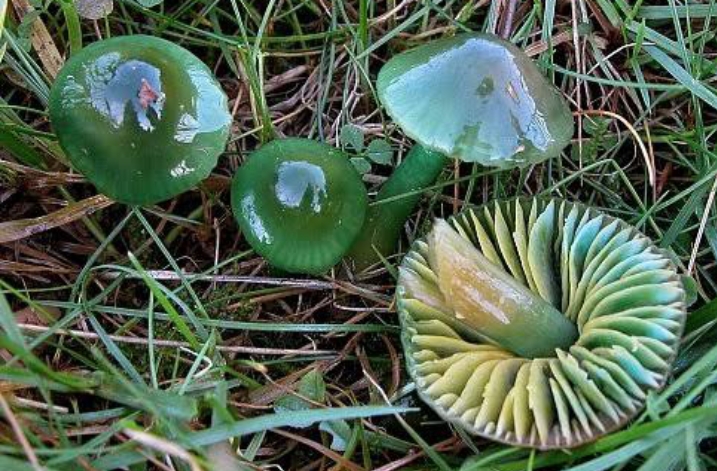
The cap is small, with a convex to umbonate shape, reaching up to 4 centimeters (1.6 inches) in diameter. It starts off green when young and can later turn yellowish or even pinkish-tinged as it matures.
The stem measures 2 to 8 centimeters (0.8 to 3.1 inches) in length and is relatively slender, with a width of 3 to 5 millimeters. It is green to greenish-yellow in color. Notably, the green coloration can persist at the stem apex, even in older specimens.
The gills are broad, adnate (attached to the stem), and have a greenish color with yellow edges. The spores are white, elliptical in shape. The spore print is white.
They are commonly found in grassy areas, meadows, heathlands and pastures. These mushrooms are widely distributed in grasslands in western Europe, United Kingdom, Iceland, Greenland, the Americas, S Africa and Japan. It is found from late summer to autumn, specifically from September to November.
Sarcomyxa serotina – Olive oysterling
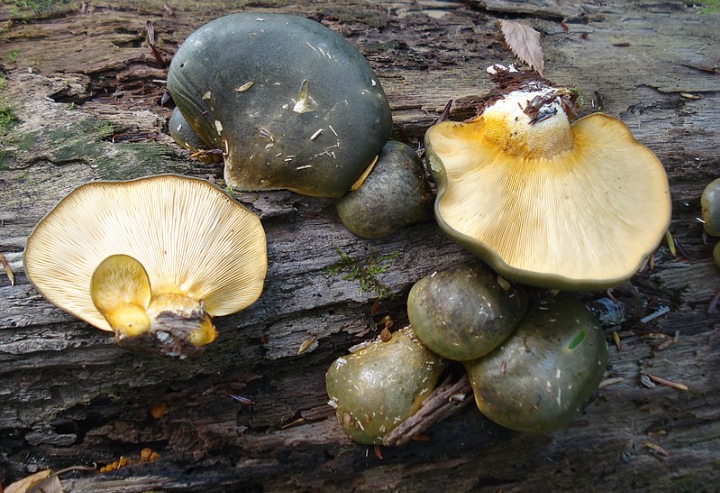
The fruit bodies of Sarcomyxa serotina have greenish, overlapping, fan- or oyster-shaped caps that grow on the wood of both coniferous and deciduous trees. The gills on the underside of the caps are closely spaced, bright orange-yellow, and have an adnate (narrow attachment) to the stipe (stem).
The species produces a yellow spore print, and the spores are smooth, amyloid, measuring 4-6 by 1-2 µm.
The species is distributed across North America, Europe, and Asia, and it can be found in both temperate and boreal forests.
In the UK, it is known as the Olive Oysterling, while in North America, it is referred to as the Late Fall Oyster or Late Oyster Mushroom. This is a late appearing mushroom, and can be found from Autumn into Winter.
While Sarcomyxa serotina is generally considered edible, it is not widely sought after for culinary use. Its mild flavor and slimy texture make it less desirable compared to other mushrooms with stronger tastes and more appealing textures.
Russula aeruginea- Grass-green russula
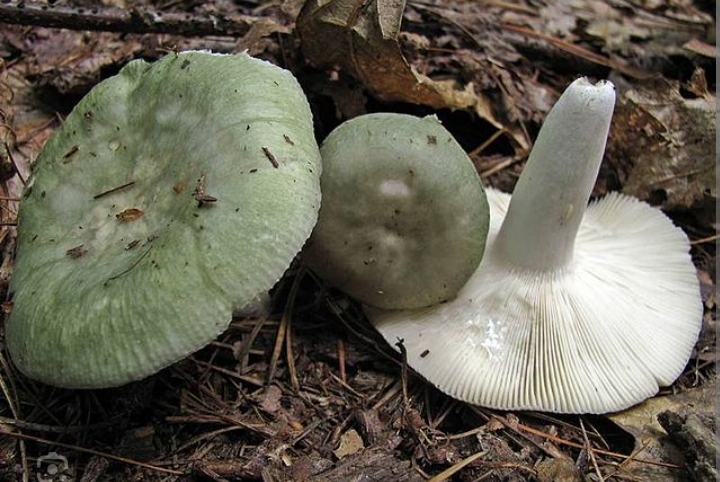
Russula aeruginea, commonly known as the Grass-Green Russula is commonly found under birch trees, particularly in pine forests. It grows on the ground in woods, in troops in leaf litter or in grass.
The cap starts flat when young and soon becomes funnel-shaped with weak stripes. It is pale green to light grey-green, and sometimes olive green. It measures 4 to 10 cm in diameter. The cap is somewhat sticky and shiny.
The gills are closely spaced and change in color from pale cream to light yellow as the spores mature. The stem is white with rust-colored spots at the base, and can be relatively short. It may have longitudinal furrows.
The spore print is cream-yellow, and the spores are spherical to oval. The flesh is white, brittle, and lacks some scent.
It’s important to note the potential confusion with Russula xerampelina, the Crab Brittlegill. While they may look similar, but Russula xerampelina has odor, which smells like cooked shellfish. In contrast, Russula aeruginea lacks any scent.
It is distributed in northern temperate regions. Fruiting occurs from July to November in Europe, and in later summer to autumn in North America. The fungus is also found in East Africa.
Lactarius semisanguifluus – Bloody Milk Cap
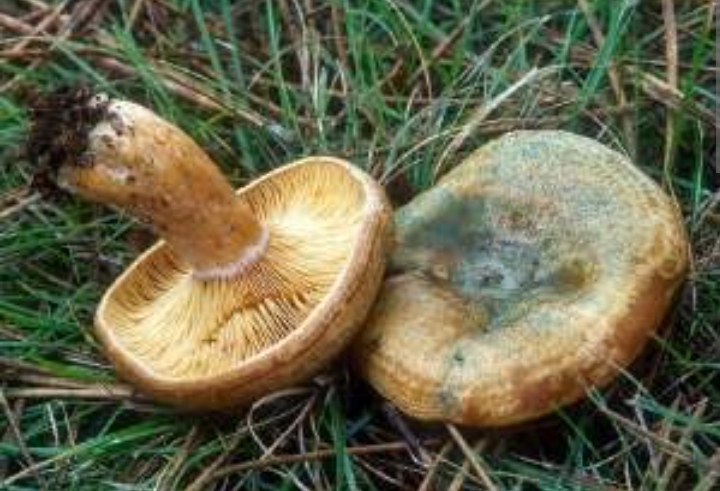
The species is distributed in regions across North America and Europe, with a preference for temperate climates. It usually appears in the late summer and autumn months.
The cap of this mushroom is convex with a central depression and it reaches a diameter of 4-7.5 cm. Its surface is smooth and sticky, with a color that ranges from pinkish-buff to orangish. There may be patches of grayish or pale greenish-gray, especially where the surface has been bruised. The cap margin remains curved downward as the mushroom matures.
The gills are somewhat crowded and have an attachment that is adnate (narrowly attached) to slightly decurrent (extending slightly down the stem). They are pale vinaceous with a pale pinkish-buff edge.
The stem is cylindrical and measures 2.0-3.5 cm long by 1-2 cm thick. Its surface is smooth and colored pale pinkish-buff to pale greyish-buff, with occasional brownish irregular dots. The flesh of the stem is soft and pale pinkish-buff.
The flesh under the cap cuticle is described as brick-colored or brownish-red, particularly just above the gills. The taste of this mushroom ranges from mild to slightly bitter. It lacks any significant odor.
Russula heterophylla- the greasy green brittlegill
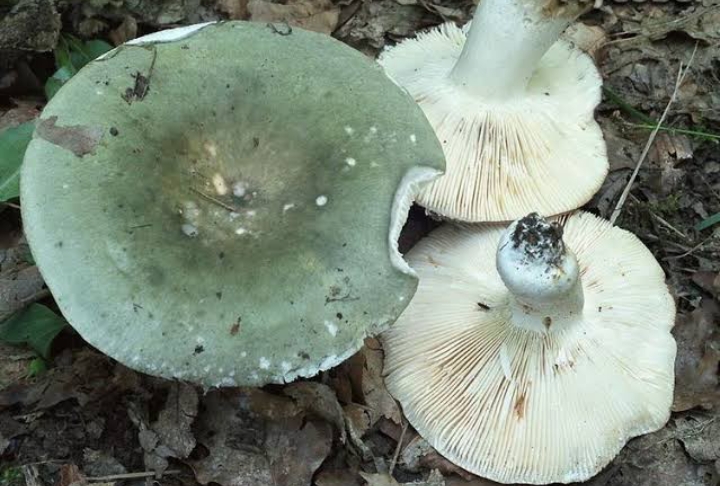
The cap of Russula heterophylla is typically 4-10 cm in diameter, though it can vary in size. It is convex when young, eventually becoming flat or somewhat depressed with age. The cap has a distinct, shiny, and slimy texture, with its color being a striking green, often described as bright green or emerald green.
The gills are somewhat crowded and are usually white or pale, but they can develop a slight pinkish tint with age. They are slightly decurrent. The stem is cylindrical, measuring 3-7 cm in length and 1-2 cm in thickness. It is white or pale, with a fragile and brittle texture.
One of the distinguishing features of the Greasy Green Brittlegill is the presence of white latex when the gills are damaged. This latex can sometimes turn yellow or creamy. The spore print is white.
Russula heterophylla is found in mixed and coniferous forests. It can grow in both acidic and calcareous soils. The species is distributed in parts of Europe and North America and can appear from late summer to early autumn.
While some Russula species are considered edible, the edibility of Russula heterophylla is not consistently reported. Some sources like Wikipedia says the Mushroom is edible. Although care must be taken. Consult with experienced mycologists or field guides when considering the edibility of any wild mushroom
Chlorociboria aeruginascens- Green elfcup
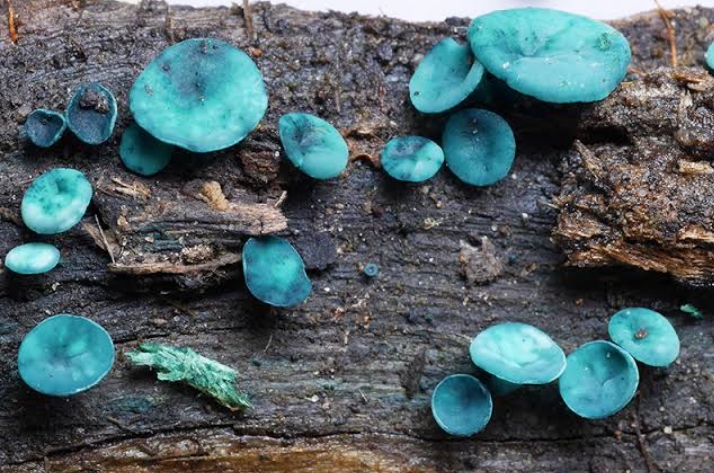
Chlorociboria aeruginascens, commonly known as the Green Elf Cup or the Green Stain Cup or the green wood cup is commonly found growing on rotting wood, especially decaying hardwoods, but it may also colonize conifers.
It occurs in regions of North America and Europe. It’s commonly encountered in temperate forests.
The Green Elf Cup has a cup-shaped fruiting body that is usually 3-10 mm in diameter. These cups are somewhat shallow and concave, resembling tiny saucers. They are attached to the substrate a central stem.
The stipe (stem) is less than 3 mm long and may have a central or eccentric attachment to the apothecia. The upper surface of the cups is green and smooth, and the underside may be a paler green or remain white.
Like many cup fungi, Chlorociboria aeruginascens releases its spores from the inner surface of the cup. When raindrops or other forces hit the cups, the spores are ejected and can be dispersed to new locations. The spore print of this species is white.
Chlorociboria aeruginascens can be distinguished from Chlorociboria aeruginosa by having smaller spores. Additionally, C. aeruginascens has smooth tomentum hyphae, in contrast to the roughened hyphae of C. aeruginosa.
Ramaria abietina- The green-staining coral
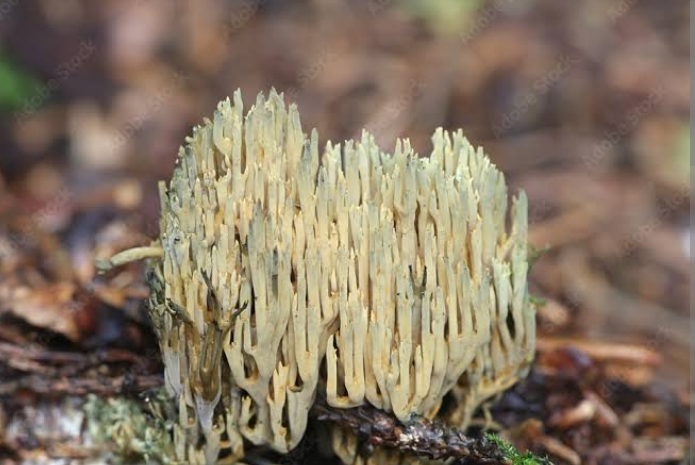
Ramaria abietina, commonly known as the Green-staining Coral is mushroom species with a complex, coral-like appearance. It grows on the forest floor among leaf litter or needle litter, where it establishes a mycorrhizal network with the roots of its host trees.
The fruiting body consists of multiple branches that radiate outwards from a central stem. These branches usually reach heights of 10-20 centimeters. When young, the branches are white to pale yellow, but they gradually turn green when exposed to air or upon bruising. This green staining reaction is its key feature that helps distinguish it from other coral fungi.
While Ramaria abietina is not typically considered edible, it is essential in the role it plays within the ecosystem. Mycorrhizal fungi like R. abietina are integral to forest health, aiding in nutrient cycling and promoting the growth of trees.
Green-staining Coral is known to occur in various regions across the Northern Hemisphere. It is found in North America, Europe, and Asia, often in coniferous and mixed forests.
Stropharia aeruginosa- verdigris agaric
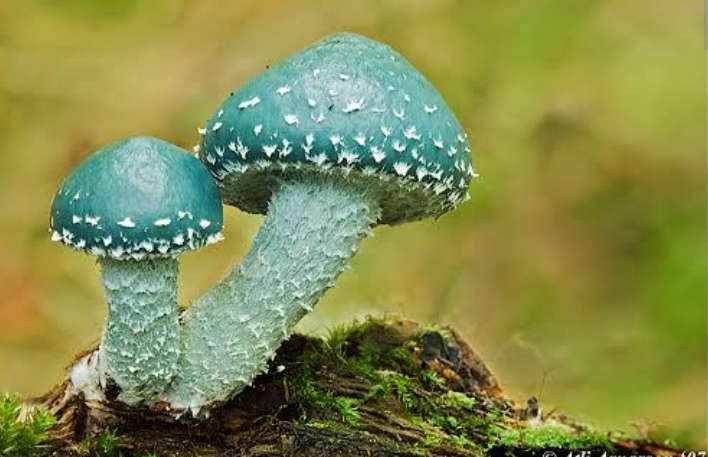
Stropharia aeruginosa, commonly known as the Verdigris Agaric or Magic Mushroom is common in woodlands, grassy areas, and on rotting wood, such as logs and tree stumps. This species has a wide distribution and can be found in North America, Europe, and other parts of the world.
The cap of Stropharia aeruginosa starts as a vivid blue/green color and is quite slimy when young, with white veil remnants around the edge. As it matures, the blue-green color fades, and it may become yellow ocher in patches, mostly at the center. Eventually, the blue-green coloration disappears. The cap is convex, broadening with age and becoming umbonate, which means it develops a central bump or knob in the middle.
The stem of this mushroom is white, relatively long with uniform thickness. It has a fragile brown/black ring. Below the ring, the stem is covered in fine white scales or flakes.
The gills of Stropharia aeruginosa initially appear white but change to clay-brown as the mushroom matures. They may have a white edge, which can create a contrast with the brown gill color. The gills are relatively close together.
The spore print of Stropharia aeruginosa is described as brownish-purple. The spores of this mushroom are oval-shaped.
Entoloma rodwayi- green stem pinkgill
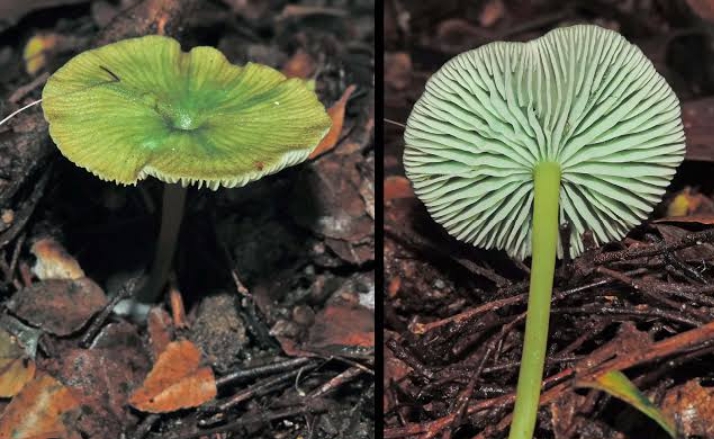
Entoloma rodwayi, commonly known as the Green-stem Pinkgill is commonly found in temperate and subtropical forests, particularly in Australia and New Zealand. It is often encountered in damp, mossy environments, such as rainforests and woodlands.
The cap of Entoloma rodwayi is small, up to 3 cm (1.2 inches) in diameter. It starts as conical or convex, but as the mushroom ages, it flattens out. The center of the cap can sometimes appear depressed. Notably, when dried, the mushroom undergoes a color transformation, changing from yellow-green to a vivid blue-green.
The gills are bright green and closely spaced and attached to the stem. In deposit, such as when obtaining a spore print, the spores of Entoloma rodwayi are pink in color. Microscopically, they exhibit angular shapes
The stem is cylindrical measuring 4-8 cm in length and 0.5-1 cm in thickness. It is also green, though the color can be paler compared to the gills. The stem has a fibrous texture and may have a whitish or pale base.
This mushroom can be confused with certain other green mushrooms, such as the larger and more solid Cortinarius austrovenetus and several species of Hygrocybe, which typically have slimy caps. However, it can be distinguished by its pink gills. The edges of the gills match the same color as the sides.
Leotia viscosa – Chicken lips

Leotia viscosa also referred to as Chicken Lips or the Green-headed Jelly Baby. The fruiting body is small, about 1-3 cm in height. It has an irregular, club-shaped or finger-like structure, resembling a miniature hand with fingers.
The upper part of the fruit body, or the “head,” is green to yellow-green, and the lower part, or the “stem,” is yellow to brownish yellow.
The fruit body is gelatinous and can feel somewhat sticky or viscid when touched, which is where the species name “viscosa” comes from. The slimy texture is more noticeable when the mushroom is moist.
Leotia viscosa is common in moist, shady woodland habitats, growing on the forest floor, on rotting wood and on roadside verges. This species can be found in parts of Britain, Europe, Asia (Iran) and parts of North America. It particularly favours wood-chip mulches in gardens and parks.
Also Read: Types of Orange Mushrooms
Cortinarius austrovenetus- Green skin-head
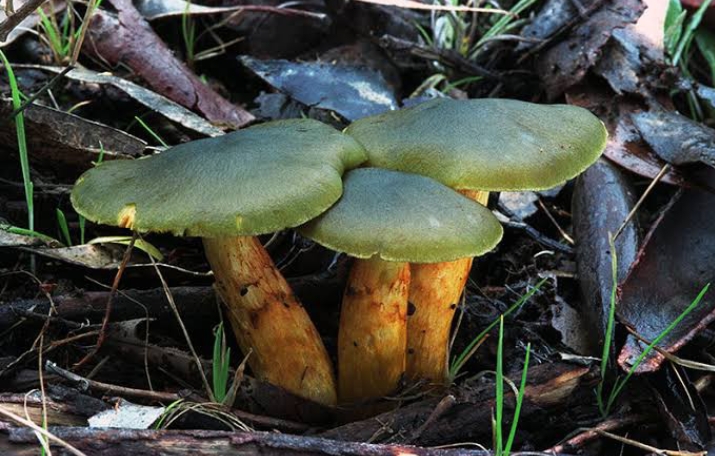
The cap of this mushroom is convex, later broadening and developing an umbo (a central knob). It measures 2-8 cm in diameter. When young, the cap is a vivid blue-green and very slimy, with white veil remnants around the edge.
As it matures, the blue-green color fades and is often washed off. The cap eventually turns yellow-ocher, sometimes with patches of blue-green remaining, mainly at the center. With further maturation, it loses the blue-green coloration entirely.
The stem is white, long, and of uniform thickness. It has a fragile brown or black ring, which is an important feature for identification. Below this ring, the stem is covered in fine white scales or flakes.
The gills start out white and become clay-brown as the mushroom matures. Sometimes, the gills may have a white edge. The spore print is brownish-purple.
The green skin-head is native to southeastern Australia. It is found on lawns, mulch, forested areas and woodland from spring to autumn. The mushroom is known to be inedible
Entoloma incanum- Mousepee Pinkgill
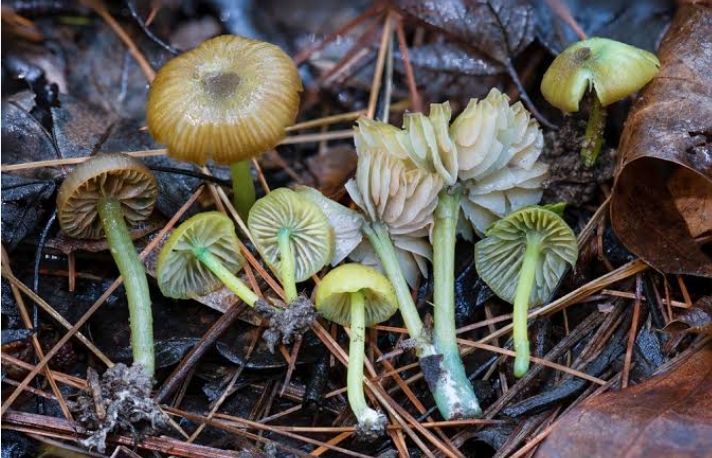
The cap of Mousepee Pinkgill is about 2 to 6 centimeters in diameter. It is convex to broadly convex when young, flattening with age. The cap surface is usually smooth and can be from pale pink to pale lilac or greyish-pink.
The gills are closely spaced and have an attachment that ranges from adnate (attached) to slightly decurrent (running down the stem). They are pink in color, hence the common name “Pinkgill.”
The stem of this mushroom is usually slender and cylindrical, having a similar color to the cap or slightly paler. It can measure 3 to 6 centimeters in length. The spore print is pale pink.
Mousepee Pinkgill is known to grow in parts of the world, particularly in North America, Europe and Asia. It can be found in forested habitats, usually in association with deciduous and coniferous trees.
Chlorophyllum molybdites – the green-spored parasol
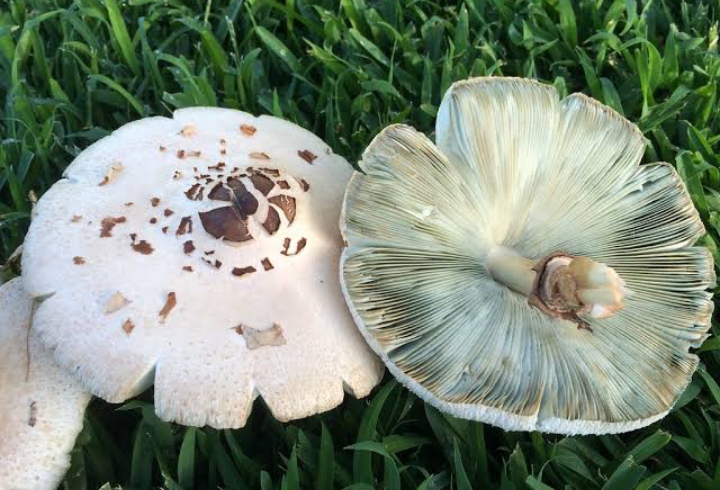
The green-spored parasol has a tall, white stalk with a prominent bulbous base and a large, umbrella-like cap. The cap is typically brownish and covered with scales. The entire mushroom can grow to a height of 15-30 cm or more, with a cap diameter of 10-25 cm. When young, the cap is somewhat oval, but it expands and becomes more convex as it matures.
The gills are white and free from the stem, and they change from white to green as the mushroom matures. The spore print is green, which is unusual and helps distinguish it from many other mushroom species.
The flesh is thick and firm when young, soft with age, white, occasionally turning reddish-brown to pale reddish-pink, especially at the base when cut or crushed.
This mushroom is common across eastern North America and California, as well as temperate and subtropical regions around the world. You can easily spot it in grassy areas, lawns, meadows, parks, gardens and open spaces.
Chlorophyllum molybdites is also referred to as the green-spored parasol, false parasol, green-spored lepiota and vomiter. It is highly poisonous and commonly confused with the shaggy parasol and shaggy mane mushrooms in North America.